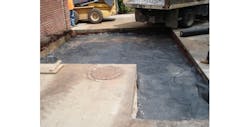A Campus Space Solution
The challenge that the University of South Carolina (USC) faced was simple: How do the 30,000 people moving in every summer – and, of that number, roughly 6,000 living on campus – get around? Considering that parking is at a premium and colleges have always scheduled classes great distances apart (to build character, naturally), many students have decided to bring bicycles and scooters along.
Many now find a parking space just for them. In a pilot project, Scott Michaud of Unit Paving and his crew recently installed a 2,000-sq-ft parking pad, made of Pine Hall Brick StormPave pavers over a best-practices system of graded aggregates.
The idea is twofold. The StormPave pavers are a good fit aesthetically for the central campus at USC, which already uses red clay pavers to define the space. They look virtually identical to the company’s English Edge pavers, which have been installed for decades. The second idea, says Michaud, is to demonstrate the usefulness of controlling storm water runoff in a small, defined space. If the pad works well, the university has plans to pursue funding for a larger project, in which 75 similarly sized pads would be placed throughout the campus. This amounts to 150,000 sq ft of StormPave permeable pavement – one of the largest StormPave installations ever.
College campuses are, by design, a good fit for permeable paving. They are usually in a defined area with a high density of impermeable surfaces, such as parking lots and buildings. Other storm water control measures, such as bioswales and retention ponds, can take up valuable real estate that could be better used for other purposes.
At USC, the addition of the pads will have additional benefits. Students and faculty will have an example of green construction, because when rainwater hits the pavers and goes around them and into the aggregates below before being absorbed into the earth, it is naturally filtered of pollutants. Also, clay pavers are made of shale and water, two of the most abundant building materials on the planet, and because they can last virtually forever, they define sustainability.
The construction is part of USC’s support of bicycling for students and faculty. The college points out the following facts about bicycle use:
• A car costs, on average, $13,532; a bike, $385.
• Trips of less than three miles are often faster by bike; trips between five and seven miles are about the same as those taken by car. Extra time on a bike also means less time needed at the gym – an average 30-minute commute burns 250 calories.
• Bikes are the most energy efficient form of transportation, getting the equivalent of 3,000 miles to the gallon.
When you consider the parking pads, the energy efficiency and the health benefits of bicycles, it adds up to experiential learning – what colleges do, in other words. To put it another way, freshman class, this is your first college lesson. You have inherited the planet. We are counting on you to help conserve it.
